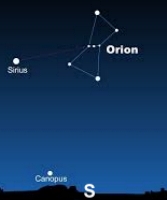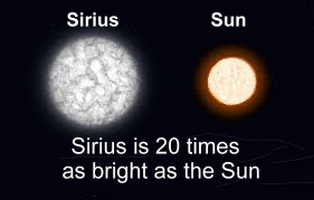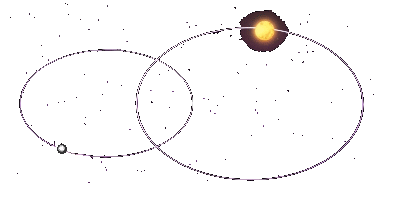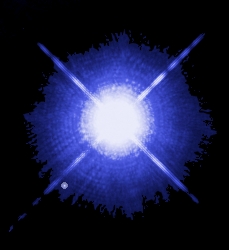  Sirius is the brightest star in the night sky. It's nicknamed the 'Dog Star' because it is part of the constellation Canis Major, Latin for 'the greater dog'. The expression 'dog days of summer' refers to the period from July 3 through August 11 when Sirius rises in conjunction with the sun.
Sirius is the brightest star in the night sky. It's nicknamed the 'Dog Star' because it is part of the constellation Canis Major, Latin for 'the greater dog'. The expression 'dog days of summer' refers to the period from July 3 through August 11 when Sirius rises in conjunction with the sun. The star in ancient times was recorded by the Greeks, Polynesians and Egyptians. The Egyptians called Sirius the 'Nile Star' because it always returned just before the river rose, announcing the coming of the floodwaters that would enrich the land with silt.  Sirius is the brightest star in the sky and the fifth nearest to Earth, at a distance of 8.6 light-years, twice the distance of the nearest known star system beyond the Sun, the Alpha Centauri system. It is a binary star. The bright component of the binary is a blue-white star over 20 times as luminous as the Sun. It has a radius 1.71 times that of the Sun, and a surface temperature just over twice that of the Sun.
Sirius is the brightest star in the sky and the fifth nearest to Earth, at a distance of 8.6 light-years, twice the distance of the nearest known star system beyond the Sun, the Alpha Centauri system. It is a binary star. The bright component of the binary is a blue-white star over 20 times as luminous as the Sun. It has a radius 1.71 times that of the Sun, and a surface temperature just over twice that of the Sun.
 The German astronomer Friedrich Wilhelm Bessel first reported that Sirius might be a binary star in 1844. He observed that Sirius was following a wavy course among nearby stars, and concluded it had a companion star, with which it revolved in a period of about 50 years. The companion was first seen in 1862 by Alvan Clark, an American astronomer and telescope maker.
The German astronomer Friedrich Wilhelm Bessel first reported that Sirius might be a binary star in 1844. He observed that Sirius was following a wavy course among nearby stars, and concluded it had a companion star, with which it revolved in a period of about 50 years. The companion was first seen in 1862 by Alvan Clark, an American astronomer and telescope maker. Sirius and its companion revolve together in orbits of considerable eccentricity and with an average separation of the stars of about 20 times Earth’s distance from the Sun. Despite the glare of the bright star, called Sirius A, the much dimmer companion Sirius B is easily seen with a large telescope. This companion star is about as massive as the Sun, though much more condensed, and was the first white dwarf star to be discovered. A white dwarf star is the last observable stage of a low- to medium-mass star like our Sun. White dwarfs get dimmer and dimmer until they eventually stop burning and go dark, thus becoming black dwarf stars, the theoretical final stage of a star's evolution. Scientists study white dwarfs like Sirius B to get a better understanding of a star's life cycle. Eventually, Earth's sun will become a white dwarf as well, in about 5 billion years.  Accurately determining the masses of white dwarfs is fundamentally important to understanding stellar evolution. The method used to determine a white dwarf's mass relies on one of the key predictions of Einstein's theory of General Relativity: that light loses energy when it attempts to escape the gravity of a compact star. The mass of a star is an important piece of information because it determines the star's core temperature and how long and hot the star will burn. Astronomers can calculate the mass of a star based on its brightness, but this was challenging for Sirius B. whose luminosity was overpowered by Sirius A.
Accurately determining the masses of white dwarfs is fundamentally important to understanding stellar evolution. The method used to determine a white dwarf's mass relies on one of the key predictions of Einstein's theory of General Relativity: that light loses energy when it attempts to escape the gravity of a compact star. The mass of a star is an important piece of information because it determines the star's core temperature and how long and hot the star will burn. Astronomers can calculate the mass of a star based on its brightness, but this was challenging for Sirius B. whose luminosity was overpowered by Sirius A.It wasn't until 2005 when data collected by the Hubble Space Telescope enabled scientists to measure the mass of Sirius B for the first time. They found that the star has a mass that is about the same as that of Earth's Sun. The image just above was taken by Hubble's Wide Field Planetary Camera. Based on detailed measurements of the position of Sirius B in this image, astronomers were then able to point the instrument exactly on the white dwarf and make the measurements to determine its mass. |